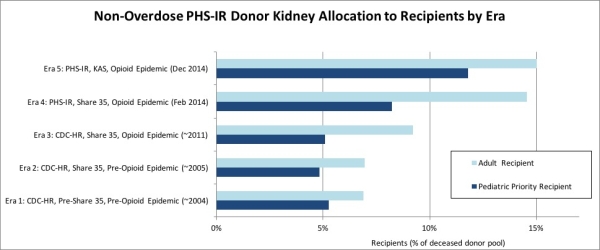Utilization of Public Health Service Increased Risk Kidneys in Pediatric Renal Transplant Recipients by Era
1Children's Hospital of Philadelphia, Philadelphia
2University of Pennsylvania, Philadelphia.
Meeting: 2018 American Transplant Congress
Abstract number: B231
Keywords: Cadaveric organs, Graft acceptance, Kidney transplantation, Pediatric
Session Information
Session Name: Poster Session B: Kidney: Pediatrics
Session Type: Poster Session
Date: Sunday, June 3, 2018
Session Time: 6:00pm-7:00pm
 Presentation Time: 6:00pm-7:00pm
Presentation Time: 6:00pm-7:00pm
Location: Hall 4EF
Purpose: Donors labeled Public Health Service Increased Risk (PHS-IR) continue to rise due to opioid abuse and expanding criteria defining 'increased-risk.' Many PHS-IR donors are young adults with low Kidney Donor Profile Index scores yet it is unknown if utilization patterns differ between pediatric and adult patients.
Methods: Retrospective study of all deceased donor (DD) isolated kidney transplant (KT) recipients in the US since outset of 'increased risk' monitoring (6/30/04-12/31/16). Recipients with pediatric priority (cases) were compared to those without (adult controls). Eras were defined by changes in pediatric priority, donor risk guidelines, and the opioid epidemic.
Results: Of 7019 pediatric priority DDKT recipients during the study period, 498 (7.1%) received a kidney from a PHS-IR donor. This compared to 16,825 (12.9% of all adult DDKT recipients; p<0.001). Since initiation of Share 35 pediatric priority, the percentage of pediatric recipients receiving a DDKT from a PHS-IR donor was significantly lower than adult recipients (p<0.001). When stratified by mechanism of death (drug overdose/non-overdose), kidneys from PHS-IR donors were utilized less frequently in pediatric recipients in all eras, with larger differences seen in donors who died from drug overdose.
Conclusion: There are differences in utilization of PHS-IR kidneys in children compared to adults. Children infrequently received PHS-IR kidneys, especially from donors who died from overdose, which may represent balancing donor transmission risk with the benefits of transplant. Further studies should examine the decision to use PHS-IR kidneys in children and the associated long-term outcomes.
CITATION INFORMATION: Meyers M., Shults J., Laskin B., Porrett P., Levine M., Abt P., Amaral S., Goldberg D. Utilization of Public Health Service Increased Risk Kidneys in Pediatric Renal Transplant Recipients by Era Am J Transplant. 2017;17 (suppl 3).
To cite this abstract in AMA style:
Meyers M, Shults J, Laskin B, Porrett P, Levine M, Abt P, Amaral S, Goldberg D. Utilization of Public Health Service Increased Risk Kidneys in Pediatric Renal Transplant Recipients by Era [abstract]. https://atcmeetingabstracts.com/abstract/utilization-of-public-health-service-increased-risk-kidneys-in-pediatric-renal-transplant-recipients-by-era/. Accessed December 21, 2025.« Back to 2018 American Transplant Congress


